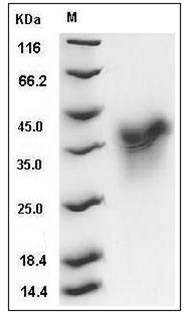-
Product Name
Human HVEM/TNFRSF14 (His Tag) recombinant protein
- Documents
-
Description
Herpesvirus entry mediator (HVEM), also referred to as TNFRSF14, TR2 (TNF receptor-like molecule) and ATAR (another TRAF-associated receptor), is a member of type I transmembrane protein belonging to the TNF-receptor superfamily. It is expressed on many immune cells, including T and B cells, NK cells, monocytes, and neutrophils. Two TNF superfamily ligands lymphotoxin α (TNF-β) and LIGHT (TNFSF14) are identified as cellular ligands for HVEM and initiate the positive signaling. However, recent studies have revealed that HVEM is also involved in the unique inhibitory signaling pathway for T cells through activating tyrosine phosphorylation of the immunoreceptor tyrosine-based inhibitory motif (ITIM) in B and T lymphocyte attenuator (BTLA). HVEM provides a stimulatory signal following engagement with LIGHT (TNFSF14) on T cells. In contrast, it can also provide an inhibitory signal to T cells when it binds the B and T lymphocyte attenuator (BTLA), a ligand member of the Immunoglobulin (Ig) superfamily. Thus, HVEM may be viewed as a molecular switch, capable of facilitating both stimulatory and inhibitory cosignaling in T cells. Substantial evidence from both human disease and from experimental mouse models has indicated that dysregulation of the LIGHT-HVEM-BTLA cosignaling pathway can cause inflammation in the lung and in mucosal tissues.
-
Protein name
Tumor necrosis factor receptor superfamily, member 14 (Herpesvirus entry mediator), isoform CRA_a
-
Protein short names
MGC123498; CD270; LIGHTR; TNFRSF14; ATAR; TNFRS14; RP24-89N4.1; RP3-395M20.6; HVEA; MGC123499; HVEM; TR2
-
Uniprot ID
Q92956
-
Gene Name
TNFRSF14; hCG_24597
-
Source/Expression Host
Human Cells
-
Expression Plasmid/cDNA
A DNA sequence encoding the extracellular domain (Met 1-Val 202) of human HVEM (NP_003811.2) was expressed, fused with a C-terminal polyhistidine tag.
-
Protein Species
Human
-
Molecular weight
The secreted recombinant human HVEM consists of 177 amino acids and predicts a molecular mass of 19 kDa. By SDS-PAGE under reducing conditions, the apparent molecular mass of rhHVEM is approximately 33-38 kDa due to glycosylation.
-
Purity
> 90 % as determined by SDS-PAGE
-
Activity
Measured by its ability to inhibit TNFβmediated cytotoxicity using L-929 mouse fibroblast cells. The ED50 for this effect is 8-32 ug/mL.
-
Validations

Human HVEM / TNFRSF14 Protein (His Tag) SDS-PAGE
Related Products / Services
Please note: All products are "FOR RESEARCH USE ONLY AND ARE NOT INTENDED FOR DIAGNOSTIC OR THERAPEUTIC USE"
